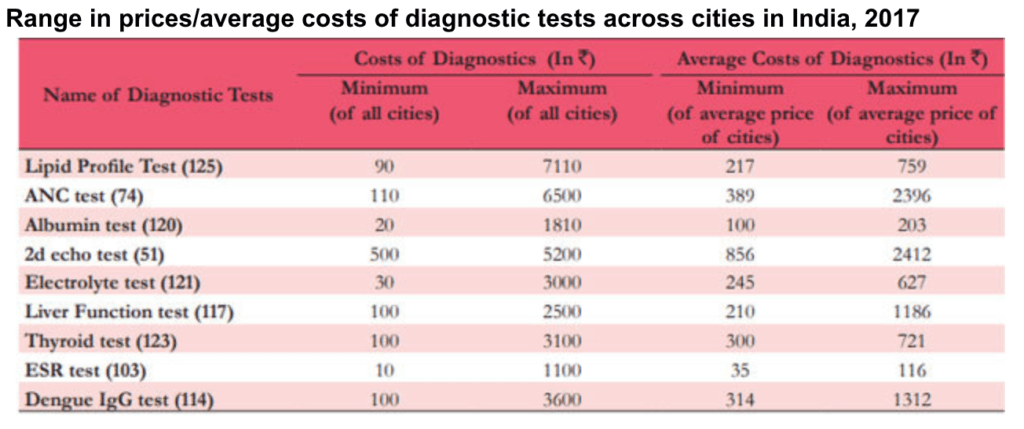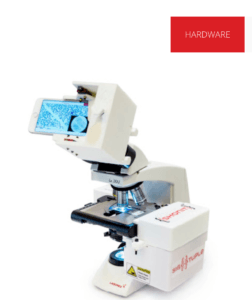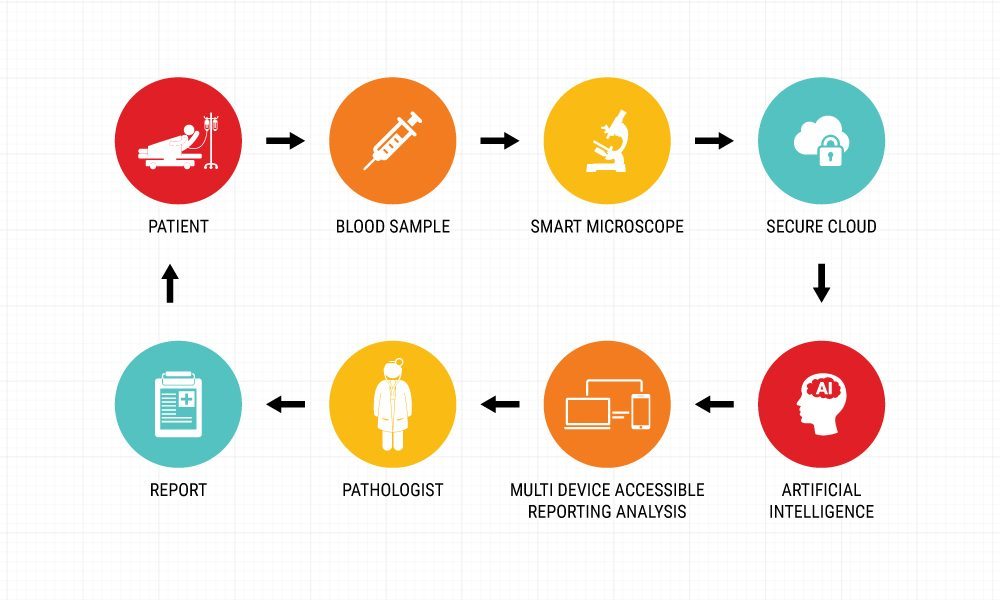Is SigTuple positioned to disrupt medical diagnostic space in India: Can Data become Doctor?

With AI and machine learning overtaking every facet of millennial industry revolution, Healthcare AI application has far-reaching potential. With advances in image recognition, improvement in robotics, Medical startups are revolutionizing the diagnostic space but are we ready for such a change? Can we allow Data to become Doctor?
It is predicted that the advent of AI-related technologies will transform all industries, as electricity did more than 100 years ago [1]. Indeed, AI and machine learning seem to be the hottest technologies in healthcare. One challenging space that SigTuple, a Bangalore based startup in India is aiming to disrupt is the medical diagnostics field using data-driven intelligence.
SigTuple’s mission is to create a data-driven, machine learned, cloud-based solution for detection and trending of anomalies using deep learning algorithms. It aims to dramatically improve the speed, accuracy, and consistency of various laboratory screening processes by providing smart screening options, which are powered by Artificial Intelligence (“AI”), better tackle cases with high inter-observer variability and improve the solution efficiency by automating much of the manual process carried out by Physicians. It wants to enable doctors to serve more patients, with fewer errors.
Is India an ideal marketplace for AI-based screening processes?
The answer would be an astounding yes! Medical diagnosis is broken in India. There’s a dearth of qualified professionals to match the vast demand. Facilities in urban areas are crowded and the quality of diagnoses suffers while rural areas don’t even get served.
Fixing India’s diagnostic woes: According to the World Health Organization (WHO) and the Indian ministry of health, there were a total 10,22,859 doctors registered with the state medical councils or Medical Council of India. Assuming 80% availability, it gives a doctor-population ratio of 0.62:1000 as per current population which is estimated to be of around 1.33 billion [2]. The WHO prescribes a minimum doctor population ratio of 1:1000. To achieve a modest doctor-to-population ratio of 1:1,000, India will need 2.07 million more doctors by 2030 [3], according to a study published in the Indian Journal of Public Health.
 Poor regulation and corruption compound these woes: As per the Economic Survey 2017-18 tabled in Parliament [4], an analysis of prices of diagnostic tests across various cities in India reveals a huge disparity in the price range as well as average pricing. The government enacted the Clinical Establishments Act, 2010, which prescribes minimum standards for clinical establishments, yet regulatory action for standardization and quality assurance is still mostly on paper, leaving a large number of laboratories unregulated and unaccredited.
Poor regulation and corruption compound these woes: As per the Economic Survey 2017-18 tabled in Parliament [4], an analysis of prices of diagnostic tests across various cities in India reveals a huge disparity in the price range as well as average pricing. The government enacted the Clinical Establishments Act, 2010, which prescribes minimum standards for clinical establishments, yet regulatory action for standardization and quality assurance is still mostly on paper, leaving a large number of laboratories unregulated and unaccredited.
SigTuple’s value proposition given this Indian context magnifies in amplitude. With its fast, automated services requiring less physician interface and capacity to deliver at fixed cost, SigTuple is positioned to fill this gap. The differentiator in ML comes mainly from the quality and quantity of data that goes into the AI engine. In the healthcare field, the availability of data is not an issue but the format in which it is available is. SigTuple’s solves the first piece of this puzzle by digitizing the slides using a smartphone and a regular microscope.
 Shonit™- the hardware device completes a peripheral blood smear analyzer solution which automates the routine tasks like differential counts. The smartphone does an auto-scan of the slides. SigTuple’s artificial intelligence (AI) platform Manthana then takes over, learning to classify and tag the visual data [5]. Finally, it generates reports containing differential blood counts, visualizations on various blood metrics and suggestions about any abnormalities. The report can then be reviewed by pathologists on any net connected device even remotely and sign off on reports — a massive step to bringing diagnostic access to remote parts of the country. The fact that it not only churns out results but also supports it with visual evidence makes it easily verifiable. The process flow of this operation can be seen below.
Shonit™- the hardware device completes a peripheral blood smear analyzer solution which automates the routine tasks like differential counts. The smartphone does an auto-scan of the slides. SigTuple’s artificial intelligence (AI) platform Manthana then takes over, learning to classify and tag the visual data [5]. Finally, it generates reports containing differential blood counts, visualizations on various blood metrics and suggestions about any abnormalities. The report can then be reviewed by pathologists on any net connected device even remotely and sign off on reports — a massive step to bringing diagnostic access to remote parts of the country. The fact that it not only churns out results but also supports it with visual evidence makes it easily verifiable. The process flow of this operation can be seen below.
But first and foremost challenge I see for SigTuple is to convince pathologists across the country on the adaptability of its product. It has to not only build a trusted network of partnerships with hospitals, labs but also overcome the prejudice against any change in the way traditional diagnosis works.
Secondly, SigTuple heavily depends on the performance of its hardware component as a starting point to the whole AI process. SigTuple is currently not set up as a hardware manufacturing company. The org structure is heavily focused on the AI domain and medical expertise but it soon needs to attract supply chain and manufacturing talents to ramp up and scale given its latest series B funding raising its investment to $24.8M [6].
Finally, as with all healthcare companies that eventually want to climb up the healthcare pyramid, going beyond screening and diagnosis to offer preventive advice, the nature of the intelligence it generates will get more intimate and the potential legal and ethical implications will get more complex. What steps if any Sigtuple can take to ensure it doesn’t become another Theranos in the history of healthcare innovation? And the deeper ethical question comes forefront in mind such as Can Shonit replace human pathologists completely? Can Data in future become a Doctor?
[795 words]
Sources
[1] Why deep learning is suddenly changing life, 26th September 2016. http://fortune.com/ai-artificial-intelligence-deep-machine-learning/
[3] Will India need more doctors, a study by Indian Journal Public Health, 28th November 2017, https://www.livemint.com/Politics/3s1uXt5sx584nLG1uiFXCI/India-will-need-207-million-more-doctors-by-2030-says-stud.html
[4] Will government standardized rates, 29 Jan 2018 //economictimes.indiatimes.com/articleshow/62696175.cms?utm_source=contentofinterest&utm_medium=text&utm_campaign=cppst
[5] Science and technology solution in Sigtuple https://sigtuple.com/#s-solutions
[6] https://www.crunchbase.com/organization/sigtuple#section-overview




Very interest article. My key concern going forward relating to the application of machine learning in healthcare diagnostics is that: who bears the liability of malpractice relating to sub-standard diagnoses and the associated negative health outcomes? I see this as one of the key roadblocks to widespread adoption because healthcare providers will be reluctant to fully automatic the diagnostic process without 100% certainty that there is no chance of error in the AI-driven process. I fear AI will be limited to a supporting role in diagnostics for the foreseeable future. Which raises the question: what is the real value add versus current methods of diagnosis?
SigTuple is trying to solve an interesting problem in the Indian healthcare context. I like the idea of digitizing the slides, but given the poor quality of infrastructure and training in India, who will control the quality of slides being prepared? How will SigTuple ensure that the remotely collected slides confer to the basic quality requirements? I am alluding to the data being fed to the intelligent systems here, and that is really an issue to be thought about while looking at a scalable solution.